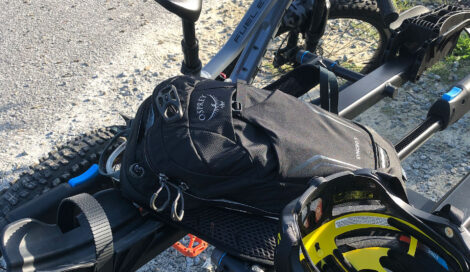
Photo by Angel Santos
I want to begin this article by acknowledging that I’m not a physical therapist and that this is not a scientist’s take on how to improve your IT band through mountain biking. However, as a rider and runner who has developed IT band issues over the last couple of years, I want to share some advice on how I have been able to move through some of the pain and feelings of muscular instability and still maintain fitness and skill on the bike.
What is IT band syndrome?
Iliotibial band syndrome is often called IT band syndrome. IT band inflammation is one of the most uncomfortable physical strains that your body has to deal with. It’s even more annoying given that there is not technically anything “broken” with your body. Instead, you have to contend with a piece of fibrous connective tissue that has gotten too tight for its own good when trying to stabilize your motion. So how do you loosen it? Well, it turns out that there are various advertised solutions, from foam rolling to dynamic stretching workouts to an active yoga regimen. The truth, however, is that there is no substitute for building strength and resting when it comes to helping your IT band get some relief.
What causes IT band syndrome?
I have no real idea of how I developed IT band issues a couple of years ago, but it was almost probably from running up and down steep grades when I lived in Asheville. Researchers are still debating the exact cause of IT band syndrome. The pain may result directly from friction as the iliotibial band moves over the lower outer edge of the thighbone.
At first, it started as a slight snapping in my right leg just above the knee when I would flex my leg. I thought it was a curious sound, but it wasn’t giving me much discomfort, so I continued with the intensity and duration of my running schedule. About a year later, I noticed that my right leg had developed some stability issues and was, in fact, much weaker than my left leg. Also, I felt some acute pain while climbing, especially on steep grades on the mountain bike. I thought it was time to start addressing the issue with my riding and strength workouts off the bike.
As soon as I got to the gym, I noticed how drastically weaker my right leg was compared to my left. A great test to see the difference in leg strength that you can do at home is to get on your knees and step up into a squat, first on one knee, then back down to kneeling, and then back up on the other knee. If you have severe IT band syndrome, you’ll notice immediately how your leg seeks (and may fail) to stabilize as you move into the squatting and standing positions. The more and more time I spent in the gym, the more I realized how much work I would need to bring my leg strength up to match the intensity of my exercise if I wanted to fix some of my IT band issues.
Mountain biking with IT band syndrome
The good news is that mountain biking with IT band syndrome can be an incredible remedy for improving leg strength and giving alternative exercise opportunities that aren’t as hard on your legs. The range of motion required and the impact are much lower during mountain biking than in running or most other weight-bearing endurance sports. The key is to focus on not smashing through a climb or getting too aggressive on downhill sections if your goal is to build strength and active recovery through a ride. The best ride for IT band pain would probably be a steady gravel climb in zones 2 or 3 (heart rate or power) and tackling a flowy but not too technical descent. Two hours of that riding will build heat in your leg and passive strength while also allowing you to recover for your next strength workout.
Running with IT band syndrome
If you are a runner trying to dabble in biking, especially mountain biking, these rides can help overcome over-training or the pounding of too many miles. After over two decades of running, my top-end pace has dropped but not so much that I can’t compete in my age group for small running races or triathlons. As a result, I’m only running about 12-20 miles max a week, combining those miles with time in the gym and mountain biking, and I’m getting all the endurance work I need with half the mileage.
Final word
Even if mountain biking is not your primary sport, it is a discipline that can be great in helping give your IT band a break from relentless use. Some great articles show how diversifying training can yield unexpected health benefits, whether you’re a road cyclist, runner, or swimmer. The key is to ride within your limits, get in a beginner trail system, and combine trail riding with any other effective remedies that are working to alleviate IT band pain. At least with mountain biking, you’ll get to be outside, which is always better than spending money and time in a physical therapist’s office.
Matthew Chisholm
Matt Chisholm is a data analyst and freelance writer who studies the environmental history of the Southern Smoky Mountain region of North Carolina. He was a contributor to Lost in Transition: Removing, Resettling, and Renewing Appalachia and the 2016 edition of the Journal of East Tennessee History, for which he won the 2017 McClung Award. When not writing, Matt enjoys road and mountain biking, hiking, trail running, and drinking beer around Concord, NC where he lives with his wife, daughter, and twin boys.
Get the email for busy mountain bikers.
Discover the best products + gear, and learn about deals from brands you love.






